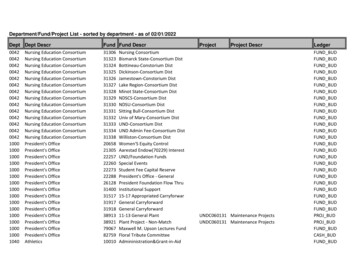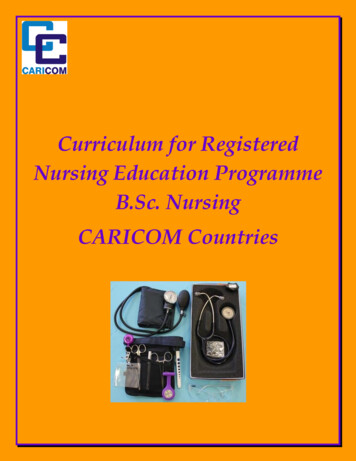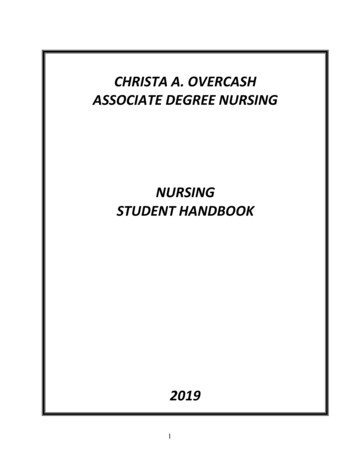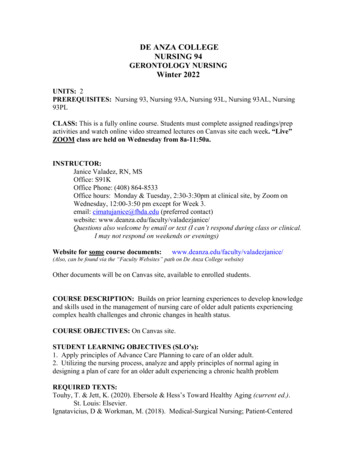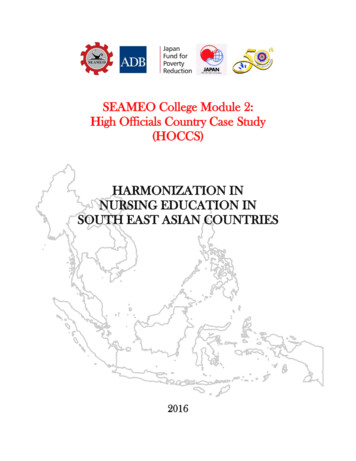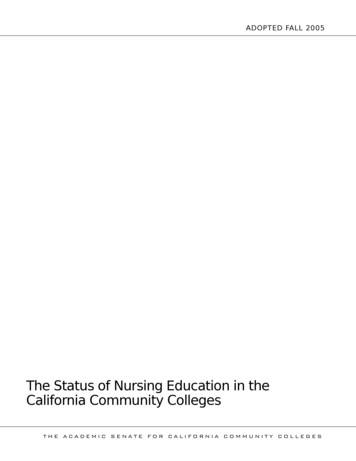
Transcription
Adopted Fall 2005The Status of Nursing Education in theCalifornia Community CollegesT h e A c a d e m i c S e n at e f o r Ca l i f o r n i a C o m m u n i t y C o l l e g e s
Nursing Task Force 2004-2005Karolyn Hanna, Santa Barbara City College, Principal AuthorSusan Herman, Chaffey CollegeWanda Morris, Compton CollegeDorothy Nunn, Cabrillo CollegeAmy Shennum, College of the CanyonsPauline Shoo, Pasadena CollegeShaaron Vogel, Butte CollegeEducational Policies Committee 2005-2006Mark Wade Lieu, Ohlone College, ChairCathy Crane-McCoy, Long Beach City CollegeGreg Gilbert, Copper Mountain CollegeKarolyn Hanna, Santa Barbara City CollegeAndrea Sibley-Smith, North Orange County CCD/NoncreditBeth Smith, Grossmont CollegeAlice Murillo, Diablo Valley College – CIO Representative
Table of ContentsAbstract . . . . . . . . . . . . . . . . . . . . . . . . . . . . . . . . . . . . . . . . . . . . . . . . . . . . . . . . . . . . . . . . . . 1Introduction . . . . . . . . . . . . . . . . . . . . . . . . . . . . . . . . . . . . . . . . . . . . . . . . . . . . . . . . . . . . . . 2Questions for Consideration. . . . . . . . . . . . . . . . . . . . . . . . . . . . . . . . . . . . . . . . . . . . . . . . . 4Conclusion and Recommendations. . . . . . . . . . . . . . . . . . . . . . . . . . . . . . . . . . . . . . . . . . . 30References . . . . . . . . . . . . . . . . . . . . . . . . . . . . . . . . . . . . . . . . . . . . . . . . . . . . . . . . . . . . . . . 31
The Status of Nursing Education in the California Community CollegesAbstractThe nursing shortage in California has prompted legislators to propose solutionsthat may be well intentioned but fail to recognize the complexity of the issuesthey are trying to address. In April 2005, the Academic Senate convened anursing task force, comprised of community college nursing faculty from acrossthe state, to examine the issues raised by outside groups, respond to these issues, andprovide possible remedies. The task force organized the information collected aroundsix questions: (1) What are the barriers to recruiting nursing students? (2) What are thebarriers negatively impacting nursing education on the campuses of California CommunityColleges? (3) What are the barriers making it difficult for students to complete theircourse of study? (4) What makes clinical placement for nursing students so difficult? (5)Why do students leave nursing programs? Why is there such a high attrition rate? (6)Once students complete their studies and enter the profession, why do so many nursesleave within a short period of time?The responses and possible remedies reflect the diversity in nursing programs across theCalifornia Community College System and the complexity of trying to find single solutionsthat work for all colleges. In some areas, there is general agreement, such as the needfor adequate numbers of full-time faculty to provide supervision and participate inprogram development, or the challenge of finding adequate slots for clinical placements.In other areas, responses differ greatly, as with respect to enrollment criteria and useof the Associate Degree in Nursing (ADN) Model Prerequisites Validation Study (Phillips,2002). The remedies proposed in the paper are those of the task force and not officialpositions of the Academic Senate. The paper concludes with recommendations that echolongstanding positions of the Academic Senate within the context of nursing education inthe California community colleges.
The Status of Nursing Education in the California Community CollegesIntroductionCommunity college nursing programs, the students they serve, the needsstudents have, and barriers students encounter vary widely. Because communitycolleges reflect the students and issues of their local communities, there is noone easy solution to help every college. In fact, what may help one program andgroup of students may not necessarily benefit another.With the intention of alleviating the current nursing shortage, California legislatorshave been active in writing legislation proposing specific solutions. In many cases, theproposed solutions fail to recognize the complexity of the issues they are trying to address.Information that legislators have about community college nursing programs, students, andthe needs of specific programs varies in completeness and does not reflect the variationin local context. In April 2005, a Nursing Task Force formed by Kate Clark, then Presidentof the Academic Senate for California Community Colleges, was charged with identifyingand responding to questions about nursing education being raised by legislators and othergroups. The goal of the Task Force members’ report was to provide an overview of thecomplexity of the nursing shortage that the Academic Senate could share with legislators,outside groups, and its own faculty. In Fall 2005, the Educational Policies Committee of theAcademic Senate reviewed and refined the Task Force report to prepare it for adoption bythe Academic Senate at its Fall Plenary Session.This report is organized around six recurrent questions being asked by those outside thecommunity college nursing programs:1. What are the barriers to recruiting nursing students?2. What are the barriers negatively impacting nursing education on the campuses ofCalifornia Community Colleges?3. What are the barriers making it difficult for students to complete their course ofstudy?4. What makes clinical placement for nursing students so difficult?5. Why do students leave nursing programs? Why is there such a high attrition rate?6. Once students complete their studies and enter the profession, why do so manynurses leave within a short period of time?
The Status of Nursing Education in the California Community Colleges“The breadth of the problemand responses provided makeclear that the issues confrontinglegislators, as they seek effectivesolutions to California’s nursingshortage, are complex.”Task Force members drew upon experiences, recent studies, and professional researchto respond to these questions and to suggest possible remedies that policy makers, localsenates, and bargaining units might consider to alleviate identified problems. It is importantto emphasize that the remedies proposed come from a diversity of perspectives andexperiences and at times may even conflict. They are not data-driven remedies but reflectthe best thinking of Task Force members, all of whom are professional nurses and nurseeducators in California community colleges. The breadth of the problem and responsesprovided make clear that the issues confronting legislators, as they seek effective solutionsto California’s nursing shortage, are complex. Inclusion of possible remedies in this reportdoes not indicate endorsement of any single remedy by the Academic Senate. The paperconcludes with recommendations that reaffirm the positions of the Academic Senate withregards to open access and equal opportunity for all of California’s residents.
The Status of Nursing Education in the California Community CollegesQuestions for Consideration1.What are the barriers to recruiting nursingstudents?Issues being raised by outside groups:uLocal or cultural demographicsuHigh school preparation or courses offereduGeneral publicly-held attitudes about the professionResponse by Task Force:uRecruitment Not Really the Issue—Recruitment of students is not perceivedas a real issue. According to the most recent Annual School Report (2005)published by the California Board of Registered Nursing (BRN), 103% of thedesignated “admission slots” in associate degree nursing programs (ADN) werefilled. It is noteworthy that although, on average, associate degree programswere filled beyond capacity, they also reported having 90 budgeted, but unfilledfaculty positions. In programs where the number of admissions was restricted,the reasons indicated were lack of faculty, lack of space, and inadequatefunding, with lack of faculty being the most common deficit. None of theprograms indicated that they experienced a lack of students. In fact, waitlistsfor admission to programs generally extend for 2-4 years, and in some cases,even longer. Lengthy waitlists are viewed as a potential deterrent for somestudents and, in fact, may compound the problem because many students applyto several programs with the hope that they might be admitted more quickly toany program.uLimited Program Capacity—How programs determine who is admitted eachyear varies. Some programs develop a queue type list, where everyone meetingadmission criteria is placed on the list and simply waits for their projectedentry date. Other programs use a lottery system to determine who is admittedin a particular year. Students who aren’t selected in the lottery one year areusually required to reapply in the following year. In general, for an applicantto be in the lottery pool or on a waitlist, they must have met all enrollmentcriteria. In any given year more than half the qualified applicants are not ableto be accommodated. In the 2003-2004 year, there were 17,887 qualified
The Status of Nursing Education in the California Community Collegesapplicants vying for 7,684 positions in California’s nursing programs (BRN,2005). Thus, over the course of ten years, thousands of qualified applicants maybe turned away. What is lost in the data currently collected is the aggregatenumber of potential nurses who give up on nursing as a career because of theirinability to get into a nursing program. In any given year more than half thequalified applicants are not able to be accommodated. This phenomenon isnot unique to California. The National League for Nursing (NLN) review of dataon nursing education programs (2004a) reported that in Fall 2003, 16% of allqualified applicants to associate degree nursing programs were “waitlisted.”Subsequently, the Executive Director of NLN issued a “wake-up call” to theprofession regarding the high number of qualified applicants being turned awayfrom nursing programs (NLN, 2004b).uDemographics—None of the Task Force participants felt that local or culturaldemographics presented a barrier to recruiting nursing students. Diversity isrepresented in both applicants and the actual student population enrolled innursing programs. This diversity does vary by area. Generally, urban schoolshave larger numbers of ethnically diverse students. All participants indicatedexperiencing some degree of difficulty in recruiting males. The BRN AnnualSchool Report indicates the distribution of students enrolled in Californiaassociate degree nursing programs as of the October 2004 census date,was as follows: White 42%, Asian 10%, Hispanic 22%, African American 9%,Native American 1%, Filipino 12%, Unknown 5%. The male-to-female ratioin associate degree nursing programs (ADN) was female 83% and male 17%(BRN, 2005). Contrasting these figures with national data indicates that thepercentage of both men and students from minority groups in nursing programs,with the exception of African Americans, is considerably higher for Californiathan the rest of the United States. National percentages for students enrolledin associate degree programs are: White 76.4%, Asian 4.2%, Hispanic 5.9%,African American 12.6%, and Native American 1.1% (NLN, 2004a). Nationallythe percentage of males enrolled in associate degree nursing programs is 12%(NLN, 2004a).uNursing Support Courses—Students inquiring into enrollment in nursingprograms are generally aware of the science requirements (Anatomy,Physiology, Microbiology, etc.). However, there are some students who havedifficulty being successful in those courses. A stronger emphasis for potentialnursing majors on the biological sciences at the high school level, might betterprepare them for success in the required science prerequisites during theircommunity college studies. There are also a number of students who seem to
The Status of Nursing Education in the California Community Collegeshave a fear of the math requirements that are either prerequisite to sciencesupport courses or required for graduation. At some level this anxiety may be adeterrent.uImpacted Required Courses—Task Force members reported that on manycampuses pre-nursing students struggle to get into required prerequisitecourses due to limited availability, particularly the sciences. For sciencecourses, existing lab facilities often limit the number of students that can beenrolled. Other courses have also been impacted by enrollment managementstrategies that require a minimum enrollment for a course to be offered. Thismay preclude offering multiple sections of courses required of pre-nursingstudents.uLack of Understanding about the Academic Rigor and Demands ofNursing—Many students who want to become nurses do not seem to havea clear understanding of what is required to be successful in an educationalprogram or what the practice of nursing is really like. They don’t anticipatethe high level of critical thinking and academic rigor involved. Nor do theyalways understand the physical and emotional demands associated withnursing. This lack of understanding may contribute to some students beingpoorly prepared to take on the challenges of nursing and nursing education andmay well account for some of the attrition in nursing programs. Given theseextrinsic physical and emotional demands, conventional academic predictorssuch as grade point average are not universally predictors of student success;thus, as discussed in Question #5 below, determining appropriate admissionsrequirements is a complex process.uPublic Perception—Task Force participants believe that the public’sperception of nursing is positive. They view nursing as a good profession toenter, find employment, and be paid well; however, here again there may be amisperception in the public’s understanding of the academic rigor required tosuccessfully complete a nursing program.Possible Remedies proposed by Task Force (remedies are the views of the TaskForce and inclusion here does not indicate endorsement by the Academic Senate):uPublicize the Rigor of Nursing Education—Although no real barriers torecruitment are seen at this time, ensuring that interested students have amore accurate understanding of the complexity and rigor of nursing educationand nursing practice may positively impact pre-entry preparation and retentionof students. (Note: See separate discussion on attrition, later in this document.)
The Status of Nursing Education in the California Community Colleges“Many students who want tobecome nurses do not seem tohave a clear understanding ofwhat is required to be successfulin an educational program or whatthe practice of nursing is reallylike.”uPresent Realistic Picture of Nursing—Opportunities for potential students togain exposure and/or experience with nursing prior to applying to and enteringa nursing program should be fostered. For example, creating partnershipsbetween nursing programs and local high schools with opportunities to enroll ina Certified Nursing Assistant (CNA) Program, to “shadow” nurses, or to becomehospital volunteers, etc. Presentations to potential applicants by current nursingstudents and/or employed nurses may also be used to present a more realisticpicture of the profession. The Employment Development Department (EDD) hasposters and flyers about health care job opportunities that could be shared withlocal high schools and placed on college campuses.uIncrease Capacity of Nursing Programs –Legislative support for increasingthe capacity of existing nursing programs and/or establishing additionalprograms would be beneficial. Although the focus of this task group is onCalifornia’s community colleges, increased capacity at all levels (associate,baccalaureate, and master’s degree) is recommended. However, a word ofcaution is essential regarding increasing program capacity without additionalfull-time faculty positions. Adding large numbers of part-time faculty increasesthe workload and stress on full-time faculty who are required to mentor and/orsupervise part-time faculty and decreases the continuity of clinical instructionfor students. In addition, it is frequently difficult to find master’s prepared nurseeducators who are willing to work on a part-time basis, as discussed later in thisdocument. (See response to Question #2). Program expansion should not beproposed without fiscal support for additional full-time faculty positions, sinceexpansion that relies heavily on part-time faculty compromises the integrity ofthe nursing program and may negatively impact other programs in the collegethat may be required to hire additional full-time faculty to compensate for theincreased use of part-time nursing faculty.
The Status of Nursing Education in the California Community CollegesuEnsure Adequate Access to Science Prerequisites—On campuses wherethe required science courses (anatomy, physiology, and microbiology) areimpacted, encourage and provide support (and funding incentives) to offereither additional sections of those courses or to offer them on a more frequentand/or reliable schedule.2.What are the barriers negatively impacting nursingeducation on the campuses of California communitycolleges?Issues being raised by outside groups:uInability to hire full-time facultyuInability to recruit part-time facultyuInability to retain part-time facultyuCosts of equipment and laboratoriesuLimitations of class sizeuLack of prerequisite coursesuRegulations such as the 75:25 ratio or the 60% law uDemands of external accrediting agenciesResponse by Task Force:uFull-time Faculty Issues—As is true for any program in the Californiacommunity colleges, a cadre of full-time faculty is essential to the health andwell-being of any nursing program. Full-time nursing faculty are responsiblefor numerous professional tasks such as revising current curriculum and/orwriting new curriculum to reflect changing healthcare needs and standards;serving on hiring committees to interview and select new full- and part-timefaculty and then mentoring and supporting them; participating in college anddistrict governance that directly impacts nursing programs and faculty; meeting The 75:25 ratio refers to the desired ratio for classes taught by full-time and part-time faculty. Thecommunity college system has as a longstanding goal that 75% of all credit courses be taught byfull-time faculty. The goal is not program specific. The 60% Law refers to the maximum load that a part-time faculty member may carry in asingle community college district. Part-time faculty who have carried loads exceeding 60% havesuccessfully sued to be granted full-time faculty positions, so districts have become very sensitiveto monitoring part-time faculty load assignments.
The Status of Nursing Education in the California Community Collegesaccreditation mandates for ongoing program evaluation (e.g. conductingsurveys of program graduates and employers; monitoring graduates’ licensingexam scores); preparing annual reports; writing grants for additional funding;maintaining significant liaisons with local hospitals, medical groups, and thecommunity; and preparing self-studies for periodic accreditation visits bymultiple agencies.Access to full-time faculty has been shown to benefit all students and enhancetheir success. The California Legislature, in enacting AB 1725, noted that the“quality, quantity and composition of full-time faculty have the most immediateand direct impact on the quality of instruction” (Section 70 (a)). Nursingstudents deserve this benefit no less than students in other programs.A number of issues identified by Task Force participants relate to hiring full-timefaculty. Nationwide there is a shortage of nurse educators, and California isexperiencing the same. The National League for Nursing (NLN) reported a 6.8%faculty vacancy rate in associate degree nursing programs in the western U.S.during the 2002-03 academic year (NLN, 2003). According to the California BRNAnnual School Report (2005), although the majority of programs were admittingstudent to capacity, for those that had reduced the number of slots available,the primary reason was “lack of faculty.” Issues contributing to this shortageinclude: Limited Availability of Master’s Prepared Nurses—The limitedavailability of nurses with master’s degrees for either full- or part-timeemployment is one of the more significant issues impacting the enrollmentand/or expansion of current nursing programs . Many factors contributeto this phenomenon, such as the cost of graduate education, increasedemployment opportunities for nurses with master’s degree in clinicalpractice (e.g., nurse practitioner, clinical nurse specialist, etc), and a recentde-emphasis on the role of nurse educator in graduate programs. Accordingto the 2004 BRN Survey of Nurses (Fletcher, 2004), only 9.2% of the workingRNs in California have an advanced (master’s or doctorate) degree innursing. (See Question #6 for additional discussion of data from this report.) Aging of Faculty—One of the most critical problems is the aging of nursingfaculty. According to the Tri-Council for Nursing Policy Statement (2001),the average age of nurse educators in the US is between 49 and 52 years.California BRN data indicates that 46% of the nurse educators in Californiaare 50 or older (BRN, 2005). To be a nursing faculty in the California community colleges requires EITHER a Master’s Degreein nursing OR a Bachelor’s Degree in nursing with a Master’s Degree in either health education orhealth science. (California Community College System Office, 2003b)
The Status of Nursing Education in the California Community Colleges“Eliminating either the 60% law or the75:25 regulation would not alleviatefaculty recruitment issues for nursingand in both the short- and long-term,would not benefit students, nursingprograms, nursing education, or thepreparation of new nurses.” Faculty Salaries—Salaries for nurse educators, prepared at (or above) themaster’s level are not commensurate with salaries for nurses with advanceddegrees who work in clinical settings (i.e. nurse practitioners, clinical nursespecialists, researchers, etc.) This is particularly true for both full- and parttime nursing faculty employed in community college nursing programs.Note: Current threats to the community college retirement program mayfurther impact recruitment of faculty, because participation in the StateTeachers Retirement System (STRS) is the one advantage that Californiacommunity colleges have had over industry in attracting qualified nurseeducators. Disproportionate Pay for Laboratory Classes—On many campuses therate of pay for laboratory time is at a lower level than for lecture time—insome cases, it is as low as 67% of the lecture rate. In nursing, where up to80% of a full-time faculty load is for clinical laboratory, faculty members areworking many more hours than their non-nursing colleagues. This furtherexacerbates the disparity between nurse educator salaries and the salariesof their counterparts working in industry and/or faculty employed in othernon-laboratory teaching positions. Lack of Support at District/College Level—Some Task Force participantsreported a high degree of local district/college support for their programs.Others described a lack of support on their local campus, especially whenrequesting new nursing faculty positions. We suspect administrative refusalsmay be related to the high cost of operating a nursing program. In othersituations, the district/college may have other pressing priorities. It was alsoreported that on some campuses, there is resentment from other facultywho believe that the political emphasis on nursing means those programs“get whatever they want.” 10The California State Teachers’ Retirement System (STRS) provides retirement related benefits andservices to teachers in public schools from kindergarten through community college.
The Status of Nursing Education in the California Community CollegesuPart-time Faculty Issues—Recruitment and retention of part-time facultycarries additional challenges beyond those identified with full-time faculty. Forsome programs, recruitment and retention is a major obstacle, and for others,it is not as significant. Problems specifically related to hiring and retaining parttime nursing faculty include: Lack of Teaching Experience and/or Expertise—Teaching and learningare complex phenomena that require skills and abilities that nurses in theworkforce may not possess. Faculty must be able to teach critical thinking,nursing process, application of theoretical concepts in the clinical setting,and performance of nursing procedures. Nurses working in a clinicalpractice setting may possess exceptional clinical skills; however they maynot have had formal coursework in teaching and learning. It has been welldocumented that when one becomes an “expert,” many of the intermediatesteps in performing a task or doing problem-solving become automatic forthat individual. When working with “novices,” those intermediate steps needto be identified and supported as students learn them (Benner, 1984). Salary and Benefits Issues—For part-time faculty, salary is also aconcern, particularly as salary schedules for part-time faculty are generallysignificantly lower than for full-time faculty. However an even greaterconcern is the lack of benefits for part-time faculty, which means thatthose individuals need to maintain employment in another agency, at alevel sufficient to qualify for benefits. The net effect is that they may notbe available on an ongoing basis, even though they would like to be. Theseuncertainties potentially affect continuity of instruction and may depriveprograms and students of very competent faculty. Impact of 75:25 and 60% Regulations—These regulations wereimplemented to provide quality instruction by maintaining a core groupof full-time faculty and enhancing faculty-student contact. While the 60%law does limit the amount of time that a part-time faculty member mayteach in any given term, community college nurse educators and theAcademic Senate for California Community Colleges support this regulationbecause it prevents those individuals from exploitation by creating apermanent underclass of faculty. Some Task Force members reported thatthis regulation has, in fact, helped support the hiring of additional full-timefaculty. Regarding the 75:25 requirement, this regulation applies to thedistrict as a whole and each department or program is NOT required to meetthat ratio. Colleges already accommodate the high number of part-timenursing faculty by hiring full-time faculty in other areas. Eliminating either11
The Status of Nursing Education in the California Community Collegesthe 60% law or the 75:25 regulation would not alleviate faculty recruitmentissues for nursing and in both the short- and long-term, would not benefitstudents, nursing programs, nursing education, or the preparation of newnurses.According to the 2003-04 California BRN Annual School Report (2005), thepercentage of full-time nursing faculty in California community collegesdecreased from 55% to 54% and part-time faculty increased from 43% to46% between 2001-02 and 2002-03. Data for the 2003-04 year is even morealarming because the ratio of full-time and part-time faculty has decreasedto 47% full-time and 53% part-time faculty.uLimited Faculty Diversity—The lack of diversity among faculty is a morechallenging issue than diversity of the student population. According to themost recent report on nursing programs, published by the California Board ofRegistered Nursing (2005), 72% of the nursing faculty is White. Statistics forother ethnic groups are as follows: African American 7%; Hispanic 8%; Asian6%; Filipino 3%; American Indian 1%; and Other/Unknown 4%.uHigh Operating Costs for Nursing Programs—While the costs of operatinga nursing program are high because of the need for facilities and equipmentin campus laboratories and low student-to-faculty ratios in the clinical area,members of the Task Force reported that through community partnerships andworking with industry, they have been able to meet many of their needs. Otherprograms have had less success in this area and find that they are working witholder (and in some cases, outdated) supplies and equipment.uLow Student/Faculty Ratios—Many states limit class size in clinicalfacilities to 10:1, and in some cases, those limits are even lower (i.e., 8:1 or9:1). A review of the Profiles of Member Boards (Crawford, 2003), publishedby the National Council of State Boards of Nursing, indicates that 37 stateshave established student faculty ratios for clinical laboratory. Of those stateswith ratios, 40% are at 8:1. At the present time, the California BRN, has notestablished ratios for clinical laboratory instruction and in some colleges,“The lack of diversity amongfaculty is a more challengingissue than diversity of the studentpopulation. “12
The Status of Nursing Education in the California Community Collegesadministrators are requiring clinical laboratory loads of up to 12 or morestudents per faculty member. With increasing acuity of patients in hospitalsand the need for close faculty supervision of students assigned to care forthose patients, the level of responsibility (and stress) for faculty members isa major issue. Effort should be directed toward changing BRN regulations toinclude specific ratios and ideally that ratio should be 8:1 for reasons of patientsafety. Such a change will further affect costs; however not changing theratio potentially affects patient safety and may impact faculty retention.
Karolyn Hanna, Santa Barbara City College, principal Author Susan Herman, Chaffey College Wanda Morris, Compton College dorothy Nunn, Cabrillo College Amy Shennum, College of the Canyons pauline Shoo, pasadena College Shaaron Vogel, Butte College Educational Policies Committee 2005-2006 Mark Wade lieu, ohlone College, Chair







